How the Trout are Saving Us:
Using Biomarkers to Improve Water Quality

By Katie Webb, CBB Biographer
January 2, 2013
Drinking water, it is said, is the next petroleum; the next great scarce resource. And as such, the conservation of what water we have is becoming of increasing importance. We must be concerned with much more than merely conserving quantities of water, we must also be concerned that what water we have remains potable. The ability to consume water is however, being put at risk as we continue to allow industrial run-off and other pollutants to contaminate it. It is ensuring the availability of high quality water, for both aquatic and human life, which is one of the current areas of research for Dr. Bernard Duncker, Associate Professor in the University of Waterloo’s Department of Biology and member of the Centre for Bioengineering and Biotechnology.
Duncker’s water-conserving work, in collaboration with Dr. Niels Bols, Dr. Brian Dixon, and Dr. James Sherry (Environment Canada), is based on his knowledge regarding DNA replication and how cells cope with the types of mutations that cause cancer. When successful, DNA replication results in two exact copies of the template genetic material being replicated. However, when this process fails, mutation can occur and it is such mutations that are a leading cause of cancer. Duncker has examined both the successful and unsuccessful end of these processes in budding yeast cultures to advance the understanding of what leads to cancer enabling mutations.
Cell cycle checkpoints—the mechanisms which cells use to recognize and cope with mutations—are at the centre of this work. Due to knowledge of cell cycle responses, specific damage can be mapped to specific toxins (and even to various levels of them). To do this, Duncker and his colleagues have examined how various budding yeast checkpoint proteins react to specific toxins or carcinogens. The level and type of damage caused by the specific toxin can then be studied and mapped to the reactions caused. This mapping allows them to also study the process in reverse, placing cells in a substance, identifying whether checkpoints have reacted, which ones, and how, and determining the presence of toxins and their concentration based on what is known to cause these reactions.
Based on this earlier work with cell cycle checkpoints in budding yeast, Duncker and his colleagues are now pioneering a biomarker-based mechanism of testing for the presence and levels of toxins, such as carcinogens, in water using rainbow trout cell lines (which they have also tested and mapped, and discovered that the reactions of fish cells operate similarly to those in budding yeast). Using the procedure they developed, the goal of Duncker and his colleagues is to check water for the presence and various levels of toxins and identify them. Not only should an initial test be able to determine levels of toxicity, but a further test after treatment could uncover the effectiveness of various treatments, determining which treatments are most successful in eliminating the toxins that human usage has permeated our water with.
It is Duncker’s goal that the use of cell cycle checkpoints in fish cell lines to test for toxins can influence the next generation of water quality tests, allowing greater precision in the analysis of water. Ultimately, providing a tool to conserve and improve the quality of a resource which is becoming ever more precious.